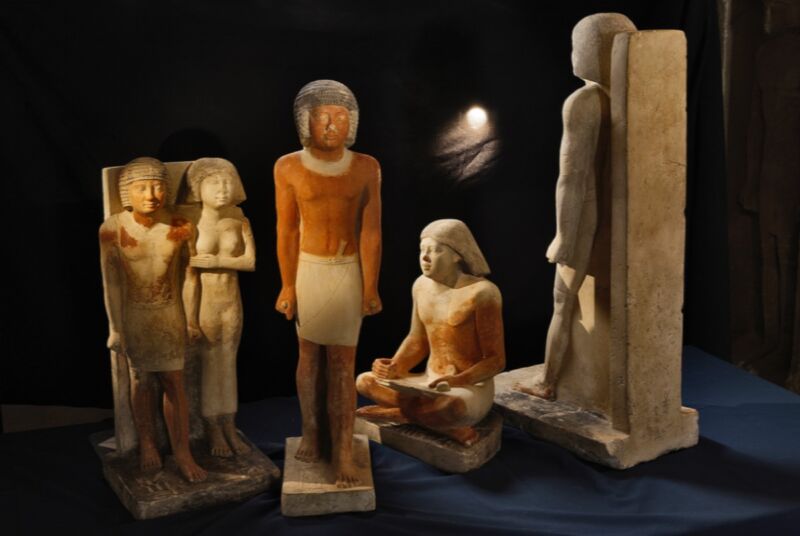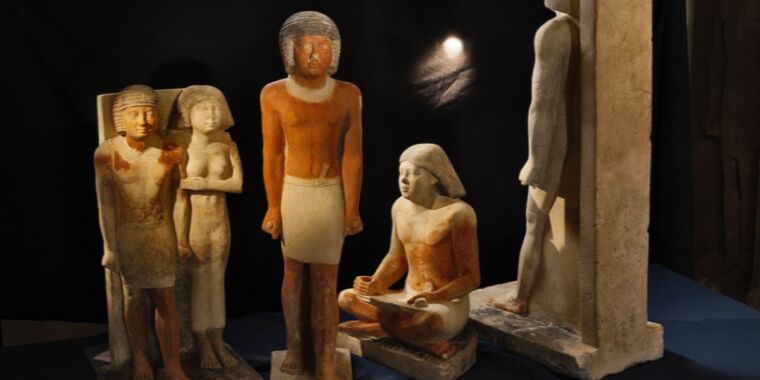Study: Scribes in ancient Egypt had really poor posture during work
a scribe’s life —
There were degenerative joint changes in the spines, shoulders, knees, hips, and ankles.

Enlarge / Statues depicting the high dignitary Nefer and his wife (Abusir, Egypt).
Martin Frouz/Czech Institute of Egyptology/Charles University.
Repetitive stress injuries are a common feature of modern life, especially for office workers who spend a good chunk of their working days at a desk typing on a computer. Apparently, scribes in ancient Egypt suffered from their own distinctive repetitive stress injuries, according to a new paper published in the journal Scientific Reports that provides fresh insights into how these scribes lived and worked during the third millennium BCE.
Egyptian kings, royal family members, and other elite people from this Fifth Dynasty era were buried in tombs in the acropolis at Abusir rather than at neighboring Giza, which by then had largely filled up thanks to all the activity during the Fourth Dynasty. The Czech Institute of Egyptology at Charles University in Prague has been conducting research at the site since 1960, leading to the discovery of nearly 200 tombs dating back to the Old Kingdom (between 2700 and 2180 BCE). The first human skeletons were excavated in 1976, and there are currently 221 Old Kingdom skeletons in the collection, 102 of which are male.
Scientists started looking into the health status and markers for specific activities in 2009, but it wasn’t until quite recently that there were enough skeletons to conduct a comprehensive study. That’s what Petra Brukner Havelková of Charles University and the National Museum in Prague, Czech Republic, and colleagues set out to do, analyzing the remains of 69 adult males of different social status and different ages at which they died.
The results show the scribes and the reference group differed in just under 4 percent of the various evaluated skeletal traits, which the authors attribute to the overall similarities in the sample (male, same age distribution, no physically demanding activities). However, the individuals identified as scribes had more degenerative joint issues clustered in several well-defined regions compared to males from other occupations, including the joint connecting the lower jaw to the skull, the right collarbone, where the right humerus meets the shoulder, the right thumb’s first metacarpal bone, where the thigh meets the knee, and all along the spine (but especially at the top). These bone changes can be indicators of repetitive stress.
Bad ergonomics?
-
Working positions of scribes. (A) cross-legged (sartorial) position, (B) kneeling-squatting position, (C) standing position. (D) Different position of the legs when sitting.
Martin Frouz/Jolana Malátková
-
Osteoarthritis of the temporomandibular joint of a supposed family member of Khemetnu, the presumed owner of family tomb AS 79.
Šárka Bejdová
-
Drawing indicating the most affected regions of the skeletons of scribes with higher prevalence of changes compared to reference group.
olana Malátková
For instance, the osteoarthritis in the jaw joints may have been caused by the rush stems the scribes used to write hieroglyphics. The scribes would chew on the ends to make a brush, and whenever a pen started getting ragged or too clogged with ink, they would cut off the end and chew the next section to make a new brush.
Most scribes likely wrote with their right hands and used their left to roll papyrus into cylindrical scrolls. Writing with a rush pen required considerable dexterity, and as anyone with carpal tunnel syndrome could tell you, these sorts of repetitive motions can cause excessive stress in the hands and wrists. There were only minor wrist differences between scribes and the control group, but the significant right thumb degeneration in scribes likely corresponds to specific frequently used thumb motions and positions—probably the act of repeatedly pinching their pens, although the authors say more research is needed to make a definitive determination.
The degenerative signs noted in the cervical spines are likely due to the scribes’ typical working position. “The head had to be forward and the spine flexed, changing the center of gravity of the head and putting stress on the spine,” the authors wrote—a posture common to many modern occupations. Prolonged stretches of sitting cross-legged could also have contributed to the observed damage to the cervical spines. There were signs of stresses to the right rotator cuffs, which usually occurs when the arm is in an extended elevated position and is common among painters, for example. It’s also common in people prone to sitting for a long time and typing with unsupported arms.
As for the degenerative changes noted in the knees, hips, and ankles, the authors suggest this indicates that scribes may have sat with the left leg in a kneeling or cross-legged position and the right leg pointed upward—more of a squat or a crouch. Iconography and statues from that era frequently depict scribes in such positions, as well as standing. The authors concluded that scribes probably alternated their arm and leg positions, but the head and cervical spine were always in that stress-inducing forward position.
Where’s a good ergonomic office chair when you need one?
DOI: Scientific Reports, 2024. 10.1038/s41598-024-63549-z (About DOIs).
Study: Scribes in ancient Egypt had really poor posture during work Read More »
